THE POHOTTUWA GOVERNMENT OF SRI LANKA Part 2 C10
Posted on January 15th, 2021
KAMALIKA PIERIS
The Indian Ocean is the third-largest ocean in the world. It is 70,560,000 km2 (27,240,000 sq mi) in extent. It is bounded by Asia to the north, Africa to the west, Australia to the east and Antarctica to the south. The Arabian Sea, the Laccadive Sea, the Somali Sea, Bay of Bengal, and the Andaman Sea are located within the Indian Ocean.
Initially, only the sea around South Asia was known as Indian Ocean. The western section was known in ancient times as the Erythraean Sea. Erythraean Sea included the Persian Gulf and Red Sea. In the 16th century the various part of the Indian Ocean was given new Latin names by European explorers. Indian Ocean was Mare Indicum. Eastern section including Bay of Bengal was Sinus Gangeticus. Red Sea and adjacent waters were known as Sinus Arabicus. The sea below Sri Lanka was known as Mare Prasodun.
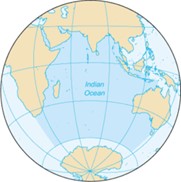
Indian Ocean
Source International Hydrographic Organization
The modern political history of the Indian Ocean begins with World War II (1939-1945) when Japan bombed Colombo harbor. When WWII ended, the Cold War between USA and Russia started. These Cold War confrontations (1947-1991) were mainly in Mediterranean, Atlantic and Pacific Oceans. However, the Indian Ocean was not forgotten, it was left in the military care of UK.
In the 1950s, UK started to lose control in the Indian Ocean. Sri Lanka for instance, took back its air and naval bases. In 1956, Egypt nationalized the Suez Canal which was ‘owned ‘by UK and France. The Suez Canal incident made US rethink, said Keerawella. US decided to set up bases in the Indian Ocean as well.
In the early 1960s, when UK decided to withdraw from the Indian Ocean US wanted to establish a navy base on one of UK’s island territories. The US requested an unpopulated island belonging to the UK. Diego Garcia was selected. In November 1965, the UK purchased the Chagos Archipelago, which includes Diego Garcia, from Mauritius and in 1966, the United States and the UK signed an agreement, which permitted the United States to use Diego Garcia, for defense purposes for 50 years until December 2016, followed by a 20-year extension to 2036.
But things did not go as planned. China emerged as a global power sooner than expected and was threatening US position as the world leader. Also economic power was now moving to Asia, thanks to the Asian Tigers and China. The richest persons in the world were now increasingly found in Asia. Asia would surpass North America and Europe combined in global power on GDP, population size, military spending, and technology by 2030, said experts.
Therefore it became necessary to somehow link the west and east geographically so that USA could continue to dominate. The Indian Ocean and the Pacific Ocean had to be brought to together as one political region.
First, an artificial Asia Pacific region was created. This Asia-Pacific included the Indian Ocean and the western Pacific Ocean. Land wise, it included East Asia, South Asia, Southeast Asia, and Oceania. Asia-Pacific Economic Cooperation (APEC) was established in 1989, for free trade between the 21 countries in the Pacific Rim. It was initiated by Australia. Australia hoped to play the leading role in APEC. But APEC was an economic concept not a security one. It was soon forgotten.
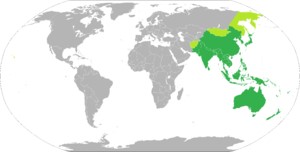
APEC countries.
With the emergence of China as a global power, a military linkup, not an economic one, was needed, a link up which would let western powers into the Indian Ocean at the military level. The idea of an ‘Indo- Pacific’ region was mooted. The term ‘Indo-Pacific brought the Indian and Pacific Ocean and landmass around them into one theatre.
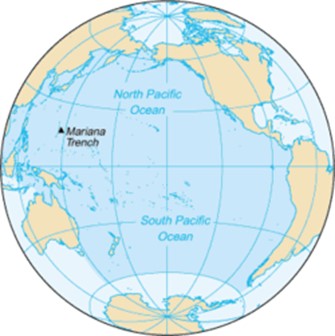
PACIFIC OCEAN
The term Indopazifischer Raum (Indo-Pacific Space), first coined by German geopolitical thinker Karl Haushofer in 1920, is perhaps the first academic statement on the Indo-Pacific, observed Asanga Abeygoonasekera.
In 2007 G.S .Khanna of the Institute of Defense Studies, New Delhi used the term Indo Pacific” combining Indian Ocean and Pacific Ocean into single regional construct, noted Keerawella. Japanese Prime Minister Shinzo Abe employed the term in his speech to the Indian Parliament in August 2007. In 2018, the US Pacific Command changed its name to Indo-Pacific Command.
Keerawella pointed out that the concept of Indo-Pacific was very useful to USA, because when the Indian and Pacific Oceans are integrated, US becomes an inside power. On the other hand, Keerawella observed, when South Asia is repositioned in the new strategic map of Indo Pacific, Sri Lanka is no longer the center as in the case of the Indian Ocean.
BAY OF BENGAL AS WAR ZONE
In the coming years, Indian Ocean region is likely to become the scene of power assertion, said Colonel Hariharan in 2010. Indian Ocean is now a heavily militarized ocean said Jayanath Colombage in 2020.At any given time there are about 120 warships. From 2008 to 2020, 575 warships from 29 different countries have visited Sri Lanka, sometimes more than one ship a week.
Bay of Bengal is now becoming a theatre of war and Sri Lanka will be at the centre, speculated analysts. In 2016, the media carried a cartoon of USA, UK, India and China warships converging on Sri Lanka. US set up its Pivot to Asia” policy in 2011. US is really going to do Asia” announced an analyst cheerfully.
US has developed the ‘Strategic island bases strategy for its war in the Bay of Bengal. The Indian newspaper, Statesman reported that US plans to use facilities in the Andaman Islands, the Comoros, the Maldives, Mauritius, Reunion, and the Seychelles (some of which are run directly or indirectly by France and India), as well as use its defense agreements with Brunei, Malaysia, and Singapore. Maldives and the US signed a Defence Agreement in 2020 to deepen engagement and cooperation in support of maintaining peace and security in the Indian Ocean.”
The small island states, lying below Sri Lanka in the Indian Ocean have become important as logistics facilities. US and China are competing for access to these logistic facilities. French, US, Italian and Japanese forces have permanent military bases In Djibouti. China joined them and set up a base in Djibouti in 2017.
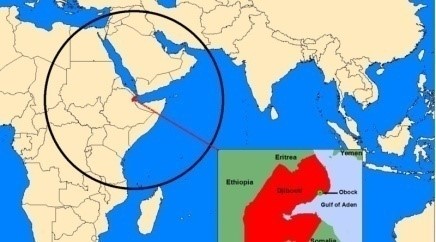
Djibouti
India has been given the task of establishing military links with the nearby islands, on behalf of USA. In Madagascar, India is building a new jetty and an airport costing USD 90- million, at the two Agalega Islands off the northeastern coast of Madagascar. These are about 1,000 kilometers north of Mauritius. There was a small protest movement against this, but it was squashed.
India also approached the Seychelles in 2020, with a proposal to build a military facility on Assumption Island, which will include an airstrip, naval jetty and a garrison of 500. There was a strong protest against it and the proposal was abandoned. China however, has a presence in Seychelles. China has built a new Parliament building and a Supreme Court in the Seychelles. China has also donated two light aircraft and two naval vessels.
Mauritius is now becoming strategically important. Britain will soon be handing over the Chagos islands to Mauritius and Mauritius can then decide to let US maintain the military base in Diego Garcia. If Mauritius agrees to this, it will then be made an associate of the Quad. This will give Mauritius significant clout in Indian Ocean affairs.
Mauritius will have the largest area of an Extended Economic Zone (EEZ) in the Indian Ocean and have islands dotted from southeast Africa to Central Indian Ocean., said analysts. They did not say how. The Secretariats of Indian Ocean Rim association (IORA) and the Indian Ocean Commission (IOC) are already located in the capital of Mauritius, Port Louis.
India has a special relationship with Mauritius. 70% of the population of Mauritius is of Indian origin and they hold the political and administrative power in Mauritius. In 2018 Mauritius was the second largest FDI contributor to India. In 2019, Mauritius has become the fourth largest FDI contributor with the US and Singapore leading in FDI flows to India. These funds are primarily from offshore companies taking advantage of tax benefits in Mauritius.
Mauritius is anti-Sri Lanka. Mauritius sponsored the resolution against Sri Lanka at the UN Human Rights Council together with the United States. It also boycotted the Commonwealth Heads of Government summit in Colombo.
It is possible that Mauritius will overtake Sri Lanka in geostrategic importance. Rising Mauritius” could offer strategic outposts for naval and military purposes across Indian Ocean. That would see a lowering in Sri Lanka’s own geographic position from a strategic standpoint though it will remain an important port for shipping, said analysts. Sri Lanka may welcome this.
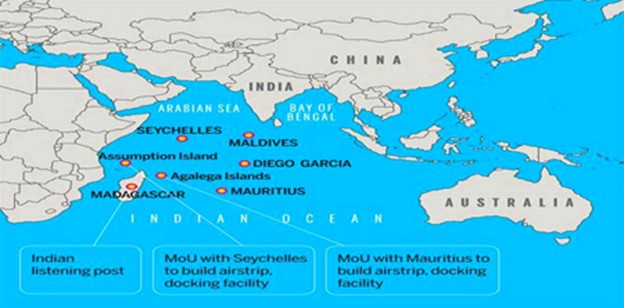
QUAD
The four Quad countries, US, India, Australia and Japan, held their first ministerial meeting in September 2019 in New York.” The four countries held joint exercises, for the first time, in the 2020 Malabar exercises in the Bay of Bengal. Indian and Japanese warships had also carried out a small exercise near the Malacca Strait in June 2020. A US carrier strike group led by aircraft carrier USS Nimitz was set to conduct an exercise with Indian warships near the Andaman and Nicobar archipelago in July 2020.
Japan joins the five eyes intelligence-sharing network in 2021. This will further strengthen the US-Japan link. The US created a five eyes spying arrangement with UK, Canada, Australia and New Zealand. Intelligence agents of these five countries work together. Each member spies on specified countries.Indonesia was allotted to Australia and Australia spied on Indonesia from its embassy in Djakarta.
US takes the view that the Quad is a powerful entity. US said that at the Quad meeting in Tokyo October 2020 in all agreed on the shared threat from China and will work together on the economic front against Beijing. Analysts reporting on the meeting are not so sure. Bolstering Quad to contain China remains a sensitive issue for the three countries due to their strong economic ties with Beijing, said reporters. India, Japan and Australia avoided calling out China directly.” Few concrete takeaways emerged from the talks. The possibility of Quad computer security architecture is remote, they said.
China has recently provoked Australia. China has drawn attention to war crimes by Australian Special Forces against Afghan prisoners and 39 civilians including children while serving in Afghanistan between 2009-2013. China broadcast a clip where Australian soldiers slit the throats of two Afghan boys, put the bodies in a bag and throw into a river. Australia demanded an apology.
It is however unlikely that there will be a direct war in the Indian Ocean between USA and China. China does not plan to come all the way to the Indian Ocean to fight America. The days when wars were fought while bobbing up and down in boats on the sea are also now over. China plans to bomb America direct, aiming over the Pacific Ocean to do so. It has created a missile called Dong” something, which can attack six places in USA in one go.
Former United States Secretary of State, Henry Kissinger fears the oncoming war. He does not think USA will win and he does not think it a good idea for US to start a war. He thinks US warmongering should stop immediately. Kissinger said in 2020, that US should move quickly to restore lines of communication with China. US and China should jointly create a negotiating group where some leader that the US President trusts and some Chinese leader that President Xi trusts remain in contact with each other on behalf of their Presidents,” Kissinger concluded. (Continued)